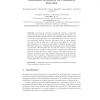Free Online Productivity Tools
i2Speak
i2Symbol
i2OCR
iTex2Img
iWeb2Print
iWeb2Shot
i2Type
iPdf2Split
iPdf2Merge
i2Bopomofo
i2Arabic
i2Style
i2Image
i2PDF
iLatex2Rtf
Sci2ools
388
click to vote
PKDD
2015
Springer
2015
Springer
Generalized Modularity for Community Detection
Detecting the underlying community structure of networks is an important problem in complex network analysis. Modularity is a well-known quality function introduced by Newman, that measures how vertices in a community share more edges than what would be expected in a randomized network. However, this limited view on vertex similarity leads to limits in what can be resolved by modularity. To overcome these limitations, we propose a generalized modularity measure called GM which has a more sophisticated interpretation of vertex similarity. In particular, GM also takes into account the number of longer paths between vertices, compared to what would be expected in a randomized network. We also introduce a unified version of GM which detects communities of unipartite and (near-)bipartite networks without knowing the structure type in advance. Experiments on di↵erent synthetic and real data sets, demonstrate GM performs strongly in comparison to several existing approaches, particularly f...
Data Mining | PKDD 2015 |
Related Content
| Added | 16 Apr 2016 |
| Updated | 16 Apr 2016 |
| Type | Journal |
| Year | 2015 |
| Where | PKDD |
| Authors | Mohadeseh Ganji, Abbas Seifi, Hosein Alizadeh, James Bailey, Peter J. Stuckey |
Comments (0)

